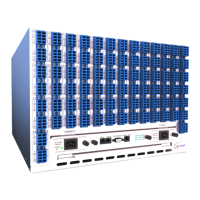S320 OCS Repair and Diagnostics Field Guide
Page 9 of 22
Use of controls, adjustments or procedures other than those specified in this
guide could result in hazardous radiation exposure.
The S320 OCS can redirect the laser energy supplied by any one of the input
fiber-optic cables to any one of the output fiber-optic cables. To avoid injury, all of
the switch’s optical connectors must either be attached to a fiber-optic cable that
is part of a closed optical system, or capped with the supplied connector covers.
Under no circumstance should attempts be made to operate this equipment with
a fiber-optic connector that is uncapped or disconnected from a closed optical
communication system fiber-optic cable.
All service to this device that requires removal of the housing panel must be
performed by the manufacturer or its authorized agent(s). Note: None of the
repairs described in this guide require removal of the housing panel.
Personnel working near any equipment carrying optical traffic may not be aware of possible
exposure to light radiating from uncovered connectors of the equipment.
If the S320’s connectors are not capped, light might escape from them and cause physical
damage to personnel. To avoid potential harm from exposure to light, always practice the
following safety measures:
Always keep fiber cables connected to all of the S320 Optical Circuit Switch connectors,
whether or not the fiber termination is providing an active cross-connection. If a cable is
not connected to a connector, be sure the connector is capped. This prevents accidental
exposure to a light source, and it also helps to prevent physical contamination of the
connector’s fiber-optic surfaces.
Never look directly into a fiber end or into any optical connector. There is no warning
when the connector is connected to a light source.
Wear the appropriate laser safety glasses when a laser source may be present. When
evaluating safety glasses, always consider the laser power, wavelength and the
manufacturer class warnings for the laser device.

